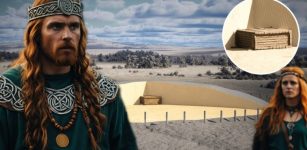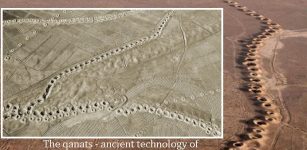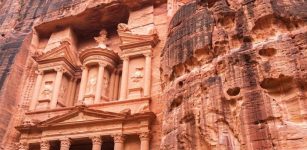Katana ‘Soul Of The Samurai’ – Most Famous Japanese Sword With Long Tradition
A. Sutherland - AncientPages.com - Katana is the most famous Japanese Samurai sword. The Japanese Katana sword is considered "the soul of the Samurai" and one of the deadliest-edged weapons used in ancient and feudal Japan by the Samurai, the members of Japan's knightly class.
Its origin, however, is not entirely known. It represents a combination of both Chinese and Japanese craftsmanship, and in its early form, it may originate from China. It is said that the enigmatic katana sword was born in fire. Since ancient times, the blade has been a symbol of faith and authority. It played an essential role as a base for the concept of the "Japanese spirit."
In his book "Katana: The Samurai Sword" Stephen Turnbull writes:
"To a samurai, one's katana was both a weapon and a symbol. Never has the relationship between man and sword been better expressed than in the words of the great shogun (military dictator) of Japan, Tokugawa Ieyasu (1542–1616), who advised his successors that 'the sword is the soul of the warrior.'
No samurai would ever be without his sword, whether he was wearing armor or everyday clothes, and a sword forged by a celebrated master was one of the most precious gifts a warrior could receive. The sword, in its rest position thrust into the belt, would tell the world that its owner was a true samurai – a member of a social and military elite – since 4 members of the lower classes did not carry weapons (theoretically, at least)…."
Old katana next to the koshirae , shirasaya and tsunagi. Image credit: Samuraiantiqueworld - CC BY-SA 3.0
It also carries the meaning of a protector between the birth and death of a person, protecting them from injury. When the Samurai turned on the sword to pull and chop in one and the same movement, it was undoubtedly awe-inspiring and deadly.
The Japanese word katana only means swords or single weapons, but it is also used as the designation of a particular sword that was used from the 17th century to the late 19th century. The Japanese history of edged weapon craftsmanship stretches back over 2,000 years.
Appearance Of Katana Weapon
In appearance, the katana is a curved, single-edged blade with a circular or squared guard and a long grip to accommodate two hands.
The mythical weapon is made of three kinds of steel with different hardness such as soft (shigane), medium-haired (kawagane), and hard steel (hagane). The process was very complicated and time-consuming and included the treatment of iron ore, which was hammered to a rod, bent in the middle, whipped together, and then bent again (up to sixteen times to get hard steel).
A katana blade - approximately 60-80 cm tall and weighs 1.1-1.3 kg - does not differ much from its immediate predecessor, the tachin, which was usually slightly lighter concerning its length and had a more curved blade that narrowed towards the tip.
What distinguished the katana from the earlier tachin was a change in how the Samurai carried the sword.
Masamune forges a katana with an assistant (ukiyo-e). Image credit: Celestial Sentinel - Public Domain
Previously, the tachin sword was traditionally worn with the cutting edge down. However, during the Muromachi Period (1392–1573), the katana was worn with the cutting edge up by the Samurai.
Advantage Of Katana Over Other Weapons In Critical Situations
Using the katana, a skilled Samurai could draw and slice his opponent with a single motion in the blink of an eye. It was essential in close-combat warfare, where victory depended heavily on short response times.
The maneuver wasn't possible with the tachin, the ancient predecessor of the katana.
Samurai warriors did not exclusively wear the katana sword. However, after 1588, only Samurai wore a katana in combination with another shorter weapon, known as "wakizashi," but this combination was legalized until 1871.
Ancient secrets of the traditional technique of Japanese swordsmithing are today known only to about 300 swordsmiths. The swordsmithing tradition has significantly declined in Japan.
However, at the beginning of the 15th century, there were about 3,550 active swordsmiths, and swords had both outstanding quality and highly artistic appearance. To receive such a sword was a great honor.
Written by – A. Sutherland - AncientPages.com Senior Staff Writer
Updated on September 5, 2022
Copyright © AncientPages.com All rights reserved. This material may not be published, broadcast, rewritten or redistributed in whole or part without the express written permission of AncientPages.com
Expand for referencesMore From Ancient Pages
-
 A Warrior’s Princely Tomb With Artifacts Unearthed In Romania
Archaeology | Dec 27, 2022
A Warrior’s Princely Tomb With Artifacts Unearthed In Romania
Archaeology | Dec 27, 2022 -
 Who Were The Satraps Of The Achaemenid Empire?
Featured Stories | Aug 28, 2021
Who Were The Satraps Of The Achaemenid Empire?
Featured Stories | Aug 28, 2021 -
 Remarkable 5,000-Year-Old Crystal Dagger Discovered In Megalithic Tomb Of Montelirio Tholos
Archaeology | Feb 13, 2021
Remarkable 5,000-Year-Old Crystal Dagger Discovered In Megalithic Tomb Of Montelirio Tholos
Archaeology | Feb 13, 2021 -
 Long-Lost Home Of Harold, The Last Anglo-Saxon King Of England Found On Depicted On The Bayeux Tapestry
Archaeology | Jan 28, 2025
Long-Lost Home Of Harold, The Last Anglo-Saxon King Of England Found On Depicted On The Bayeux Tapestry
Archaeology | Jan 28, 2025 -
 Giant Bath Tub Built For Tsar Alexander I – Why Was It So Large?
Featured Stories | Jul 11, 2018
Giant Bath Tub Built For Tsar Alexander I – Why Was It So Large?
Featured Stories | Jul 11, 2018 -
 Face Of A Greek Girl That Lived 9,000-Years Ago Reconstructed In Athens
Archaeology | Jan 27, 2018
Face Of A Greek Girl That Lived 9,000-Years Ago Reconstructed In Athens
Archaeology | Jan 27, 2018 -
 Were There Gladiators In Roman Britain? An Expert Reviews The Evidence
Featured Stories | Mar 14, 2023
Were There Gladiators In Roman Britain? An Expert Reviews The Evidence
Featured Stories | Mar 14, 2023 -
 Who Were The Blue People Of Kentucky?
Featured Stories | Apr 5, 2022
Who Were The Blue People Of Kentucky?
Featured Stories | Apr 5, 2022 -
 Who Is Buried In The Extremely Well-Preserved 2,600-Year-Old Celtic Chamber Tomb Found Near Riedlingen, Germany?
Archaeology | Oct 24, 2024
Who Is Buried In The Extremely Well-Preserved 2,600-Year-Old Celtic Chamber Tomb Found Near Riedlingen, Germany?
Archaeology | Oct 24, 2024 -
 Qanats: Ancient 3,000-Year-Old Underground Irrigation Canals Invented By People Of Persia
Ancient Technology | Jul 13, 2020
Qanats: Ancient 3,000-Year-Old Underground Irrigation Canals Invented By People Of Persia
Ancient Technology | Jul 13, 2020 -
 Mystery Of The Gold From Troy, Poliochni And Ur Solved!
Archaeology | Dec 2, 2022
Mystery Of The Gold From Troy, Poliochni And Ur Solved!
Archaeology | Dec 2, 2022 -
 Mystery Of The Thirteen Towers Of Chankillo – Oldest ‘Full-Service Observatory’ In The Western Hemisphere
Featured Stories | Nov 6, 2018
Mystery Of The Thirteen Towers Of Chankillo – Oldest ‘Full-Service Observatory’ In The Western Hemisphere
Featured Stories | Nov 6, 2018 -
 19th Century Mass Grave With Hundreds Decapitated “Vampires” Discovered In Polish Village
Archaeology | Jun 23, 2023
19th Century Mass Grave With Hundreds Decapitated “Vampires” Discovered In Polish Village
Archaeology | Jun 23, 2023 -
 Stone Age Europe Had Nine Distinct Cultures – Ancient Jewelry Reveals
Archaeology | Feb 3, 2024
Stone Age Europe Had Nine Distinct Cultures – Ancient Jewelry Reveals
Archaeology | Feb 3, 2024 -
 Were Mysterious Giant Ancient Mustatils In Saudi Arabia Used For Ritual Purposes?
Archaeology | Mar 16, 2023
Were Mysterious Giant Ancient Mustatils In Saudi Arabia Used For Ritual Purposes?
Archaeology | Mar 16, 2023 -
 Indigenous Communities Used The Caribbean Sea As An Aquatic Highway
Archaeology | Jun 23, 2022
Indigenous Communities Used The Caribbean Sea As An Aquatic Highway
Archaeology | Jun 23, 2022 -
 Who Was The Unknown Man Who Influenced Historical Events Shaping America’s Future Before Vanishing Forever?
Featured Stories | Jan 19, 2025
Who Was The Unknown Man Who Influenced Historical Events Shaping America’s Future Before Vanishing Forever?
Featured Stories | Jan 19, 2025 -
 Biblical Mosaic Depicting Miracles Of Jesus Discovered At The ‘Burnt Church’ In Hippos
Archaeology | Sep 24, 2019
Biblical Mosaic Depicting Miracles Of Jesus Discovered At The ‘Burnt Church’ In Hippos
Archaeology | Sep 24, 2019 -
 Ireland, Wales And The Scholar Who Helped Unravel Their Celtic Connections
Featured Stories | Sep 25, 2024
Ireland, Wales And The Scholar Who Helped Unravel Their Celtic Connections
Featured Stories | Sep 25, 2024 -
 Researchers Sequenced 137 Human Genomes From The Middle East
Archaeology | Aug 6, 2021
Researchers Sequenced 137 Human Genomes From The Middle East
Archaeology | Aug 6, 2021



